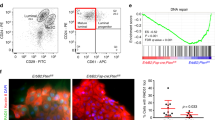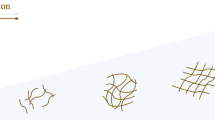Abstract
Ionizing radiation is a well-established carcinogen in human breast and rodent mammary gland. This review addresses evidence that radiation elicits the critical stromal context for cancer, affecting not only frequency but the type of cancer. Recent data from the breast tumors of women treated with radiation therapy and the cellular mechanisms evident in experimental models suggest that radiation effects on stromal-epithelial interactions and tissue composition are a major determinant of cancer development.
Similar content being viewed by others
Abbreviations
- TGFβ:
-
Transforming growth factor β
- ER:
-
estrogen receptor
- PR:
-
progesterone receptor
- EMT:
-
epithelial-mesenchymal transition
References
Rubin H. Cancer as a dynamic developmental disorder. Cancer Res. 1985;45:2935–42.
Barcellos-Hoff MH. The potential influence of radiation-induced microenvironments in neoplastic progression. J Mammary Gland Biol Neoplasia. 1998;3:165–75.
Sonnenschein C, Soto AM. Somatic mutation theory of carcinogenesis: why it should be dropped and replaced. Mol Carcinog. 2000;29(4):205–11.
Bissell MJ, Radisky D. Putting tumours in context. Nat Rev Cancer. 2001;1(1):1–11.
Wiseman BS, Werb Z. Stromal effects on mammary gland development and breast cancer. Science. 2002;296(5570):1046–9.
Kuperwasser C, Chavarria T, Wu M, Magrane G, Gray JW, Carey L, et al. From the cover: reconstruction of functionally normal and malignant human breast tissues in mice. PNAS. 2004;101(14):4966–71.
Bhowmick NA, Chytil A, Plieth D, Gorska AE, Dumont N, Shappell S, et al. TGF-{beta} signaling in fibroblasts modulates the oncogenic potential of adjacent epithelia. Science. 2004;303(5659):848–51.
Maffini MV, Soto AM, Calabro JM, Ucci AA, Sonnenschein C. The stroma as a crucial target in rat mammary gland carcinogenesis. J Cell Sci. 2004;117(8):1495–502.
de Visser KE, Eichten A, Coussens LM. Paradoxical roles of the immune system during cancer development. Nat Rev Cancer. 2006;6(1):24–37.
Barcellos-Hoff MH, Ravani SA. Irradiated mammary gland stroma promotes the expression of tumorigenic potential by unirradiated epithelial cells. Cancer Res. 2000;60:1254–60.
NAS/NRC. Health risks from exposure to low levels of ionizing radiation: phase 2. Washington: National Academy Press; 2006.
Barcellos-Hoff MH. Cancer as an emergent phenomenon in systems radiation biology. Radiat Env Biophys. 2007;47(1):33–8.
Herskind C, Rodemann HP. Spontaneous and radiation-induced differentiationof fibroblasts. Exp Gerontol. 2000;35(6-7):747–55.
Rave-Frank M, Virsik-Kopp P, Pradier O, Nitsche M, Grunefeld S. H. S. In vitro response of human dermal fibroblasts to X-irradiation: relationship between radiation-induced clonogenic cell death, chromosome aberrations and markers of proliferative senescence or differentiation. Int J Radiat Biol. 2001;77:1163–74.
Park CC, Henshall-Powell RL, Erickson AC, Talhouk R, Parvin B, Bissell MJ, et al. Ionizing radiation induces heritable disruption of epithelial cell interactions. Proc Natl Acad Sci USA. 2003;100(19):10728–33.
Tsai KK, Chuang EY, Little JB, Yuan ZM. Cellular mechanisms for low-dose ionizing radiation-induced perturbation of the breast tissue microenvironment. Cancer Res. 2005;65(15):6734–44.
Kadhim MA, Lorimore SA, Hepburn MD, Goodhead DT, Buckle VJ, Wright EG. Alpha-particle-induced chromosomal instability in human bone marrow cells. Lancet. 1994;344(8928):987–8.
Kadhim MA, Lorimore SA, Townsend KM, Goodhead DT, Buckle VJ, Wright EG. Radiation-induced genomic instability: delayed cytogenetic aberrations and apoptosis in primary human bone marrow cells. Int J Radiat Biol. 1995;67(3):287–93.
Kadhim MA, Macdonald DA, Goodhead DT, Lorimore SA, Marsden SJ, Wright EG. Transmission of chromosomal instability after plutonium alpha-particle irradiation [see comments]. Nature. 1992;355(6362):738–40.
Clutton SM, Townsend KM, Goodhead DT, Ansell JD, Wright EG. Differentiation and delayed cell death in embryonal stem cells exposed to low doses of ionising radiation. Cell Death Differ. 1996;3(1):141–8.
Limoli CL, Kaplan MI, Corcoran J, Meyers M, Boothman DA, Morgan WF. Chromosomal instability and its relationship to other end points of genomic instability. Cancer Res. 1997;57(24):5557–63.
Preston DL, Pierce DA, Shimizu Y, Ron E, Mabuchi K. Dose response and temporal patterns of radiation-associated solid cancer risks. Health Phys. 2003;85(1):43–6.
Preston DL, Ron E, Tokuoka S, Funamoto S, Nishi N, Soda M, et al. Solid cancer incidence in atomic bomb survivors: 1958-1998. Radiat Res. 2007;168(1):1–64.
Preston DL, Mattsson A, Holmberg E, Shore R, Hildreth NG, Boice Jr JD. Radiation effects on breast cancer risk: a pooled analysis of eight cohorts. Radiat Res. 2002;158(2):220–35.
Castiglioni F, Terenziani M, Carcangiu ML, Miliano R, Aiello P, Bertola L, et al. Radiation effects on development of HER2-positive breast carcinomas. Clin Cancer Res. 2007;13(1):46–51.
Van Leeuwen FE, Klokman WJ, Stovall M, Dahler EC, van’t Veer MB, Noordijk EM, et al. Roles of radiation dose, chemotherapy, and hormonal factors in breast cancer following Hodgkin’s disease. J Natl Cancer Inst. 2003;95(13):971–80.
Broeks A, Braaf LM, Wessels LF, Van de Vjver M, De Bruin ML, Stovall M, et al. Radiation-associated breast tumors display a distinct gene expression profile. Int J Radiat Oncol Biol Phys. 2010;76(2):540–7.
Barcellos-Hoff MH. Integrative radiation carcinogenesis: interactions between cell and tissue responses to DNA damage. Semin Cancer Biol. 2005;15(2):138–48.
Kaplan HS, Carnes WH, Brown MB, Hirsch BB. Indirect induction of lymphomas in irradiated mice: I. Tumor incidence and morphology in mice bearing nonirradiated thymic grafts. Cancer Res. 1956;16(5):422–5.
Kaplan HS, Brown MB, Hirsch BB, Carnes WH. Indirect induction of lymphomas in irradiated mice: II. Factor of irradiation of the host. Cancer Res. 1956;16(5):426–8.
Carnes WH, Kaplan HS, Brown MB, Hirsch BB. Indirect induction of lymphomas in irradiated mice: III. Role of the thymic graft. Cancer Res. 1956;16(5):429–33.
Billingham RE, Orr JW, Woodhouse DL. Transplantation of skin components during chemical carcinogenesis with 20-methylcholanthrene. Br J Cancer. 1951;5:417–32.
Morgan JE, Gross JG, Pagel CN, Beauchamp JR, Fassati A, Thrasher AJ, et al. Myogenic cell proliferation and generation of a reversible tumorigenic phenotype are triggered by preirradiation of the recipient site. J Cell Biol. 2002;157(4):693–702.
Ohuchida K, Mizumoto K, Murakami M, Qian L-W, Sato N, Nagai E, et al. Radiation to stromal fibroblasts increases invasiveness of pancreatic cancer cells through tumor-stromal interactions. Cancer Res. 2004;64(9):3215–22.
Terzaghi M, Little JB. X-radiation-induced transformation in C3H mouse embryo-derived cell line. Cancer Res. 1976;36:1367–74.
Terzaghi M, Nettesheim P. Dynamics of neoplastic development in carcinogen-exposed tracheal mucosa. Cancer Res. 1979;39:3004–10.
Kennedy AR, Fox M, Murphy G, Little JB. Relationship between x-ray exposure and malignant transformation in C3H 10 T1/2 cells. Proc Natl Acad Sci USA. 1980;77(12):7262–6.
Bauer G. Elimination of transformed cells by normal cells: a novel concept for the control of carcinogenesis. Histol Histopathol. 1996;11(1):237–55.
Engelmann I, Eichholtz-Wirth H, Bauer G. Ex vivo tumor cell lines are resistant to intercellular induction of apoptosis and independent of exogenous survival factors. Anticancer Res. 2000;20(4):2361–70.
Terzaghi-Howe M. Inhibition of carcinogen-altered rat tracheal epithelial cell proliferation by normal epithelial cells in vivo. Carcinogenesis. 1986;8:145–50.
Häufel T, Dormann S, Hanusch J, Schwieger A, Bauer G. Three distinct roles for TGF-beta during intercellular induction of apoptosis: a review. Anticancer Res. 1999;19(1A):105–11.
Portess DI, Bauer G, Hill MA, O’Neill P. Low dose irradiation of non-transformed cells stimulates the selective removal of pre-cancerous cells via intercellular induction of apoptosis. Cancer Res. 2007;67(3):1246–53.
Barcellos-Hoff MH. Radiation-induced transforming growth factor β and subsequent extracellular matrix reorganization in murine mammary gland. Cancer Res. 1993;53:3880–6.
Ehrhart EJ, Gillette EL, Barcellos-Hoff MH. Immunohistochemical evidence of rapid extracellular matrix remodeling after iron-particle irradiation of mouse mammary gland. Rad Res. 1996;145:157–62.
Ehrhart EJ, Carroll A, Segarini P, Tsang ML-S, Barcellos-Hoff MH. Latent transforming growth factor-β activation in situ: quantitative and functional evidence following low dose irradiation. FASEB J. 1997;11:991–1002.
Barcellos-Hoff MH, Derynck R, Tsang ML-S, Weatherbee JA. Transforming growth factor-β activation in irradiated murine mammary gland. J Clin Invest. 1994;93:892–9.
Barcellos-Hoff MH. How do tissues respond to damage at the cellular level? The role of cytokines in irradiated tissues. Radiat Res. 1998;150(5):S109–20.
Jerry DJ, Medina D, Butel JS. p53 mutations in COMMA-D cells. In Vitro Cell. Dev Biol. 1994;30A:87–9.
Medina D, Kittrell FS. Stroma is not a major target in 7, 12-dimethlybenzanthracene mediated tumorigenesis of mouse mammary preneoplasia. J Cell Sci. 2005;118:123–7.
Jerry DJ, Kittrell FS, Kuperwasser C, Laucirica R, Dickinson ES, Bonilla PJ, et al. A mammary-specific model demonstrates the role of the p53 tumor suppressor gene in tumor development. Oncogene. 2000;19(8):1052–8.
Medina D, Kittrell FS, Shepard A, Stephens LC, Jiang C, Lu J, et al. Biological and genetic properties of the p53 null preneoplastic mammary epithelium. FASEB J. 2002;16(8):881–3.
Tokunaga M, Land CE, Aoki Y, Yamamoto T, Asano M, Sato E, et al. Proliferative and nonproliferative breast disease in atomic bomb survivors. Results of a histopathologic review of autopsy breast tissue. Cancer. 1993;72(5):1657–65.
Boice JD Jr, Preston D, Davis FG, Monson RR. Frequent chest x-ray fluoroscopy and breast cancer incidence among tuberculosis patients in Massachusetts. Radiat Res. 1991;125:214–22.
Hancock SL, Tucker MA, Hoppe RT. Breast cancer after treatment of Hodgkin's disease. J Natl Cancer Inst. 1993;85(1):25–31.
Howe GR, McLaughlin J. Breast cancer mortality between 1950 and 1987 after exposure to fractionated moderate-dose-rate ionizing radiation in the Canadian fluoroscopy cohort study and a comparison with breast cancer mortality in the atomic bomb survivor study. Radiat Res. 1996;145:694–707.
Booth C, Potten CS. Gut instincts: thoughts on intestinal epithelial stem cells. J Clin Invest. 2000;105(11):1493–9.
Potten CS, Loeffler M. Stem cells: attributes, cycles, spirals, pitfalls and uncertainties. Lessons for and from the crypt. Development. 1990;110(4):1001–20.
Gyorki D, Asselin-Labat M-L, van Rooijen N, Lindeman G, Visvader J. Resident macrophages influence stem cell activity in the mammary gland. Breast Cancer Res. 2009;11(4):R62.
Psaila B, Lyden D. The metastatic niche: adapting the foreign soil. Nat Rev Cancer. 2009;9(4):285–93.
Hatsell S, Rowlands T, Hiremath M, Cowin P. beta-Catenin and Tcfs in mammary development and cancer. J Mammary Gland Biol Neoplasia. 2003;8:145–58.
Liu BY, McDermott SP, Khwaja SS, Alexander CM. The transforming activity of Wnt effectors correlates with their ability to induce the accumulation of mammary progenitor cells. PNAS. 2004;101(12):4158–63.
Teissedre B, Pinderhughes A, Incassati A, Hatsell S, Hiremath M, Cowin P. MMTV-Wnt1 and -DeltaN89beta-catenin induce canonical signaling in distinct progenitors and differentially activate Hedgehog signaling within mammary tumors. PLoS ONE. 2009;4:e4537.
Incassati A, Pinderhughes A, Eelkema R, Cowin P. Links between transforming growth factor-beta and canonical Wnt signaling yield new insights into breast cancer susceptibility, suppression and tumor heterogeneity. Breast Cancer Res. 2009;11(3):103.
Booth BW, Mack DL, Androutsellis-Theotokis A, McKay RDG, Boulanger CA, Smith GH. The mammary microenvironment alters the differentiation repertoire of neural stem cells. Proc Natl Acad Sci. 2008;105(39):14891–6.
Boulanger CA, Mack DL, Booth BW, Smith GH. Interaction with the mammary microenvironment redirects spermatogenic cell fate in vivo 10.1073/pnas.0611637104. PNAS. 2007;104(10):3871–6.
Smith G, Medina D. Re-evaluation of mammary stem cell biology based on in vivo transplantation. Breast Cancer Res. 2008;10(1):203.
Andarawewa KL, Erickson AC, Chou WS, Costes SV, Gascard P, Mott JD, et al. Ionizing radiation predisposes nonmalignant human mammary epithelial cells to undergo transforming growth factor beta Induced epithelial to mesenchymal transition. Cancer Res. 2007;67:8662–70.
Mani SA, Guo W, Liao M-J, Eaton EN, Ayyanan A, Zhou AY, et al. The epithelial-mesenchymal transition generates cells with properties of stem cells. Cell. 2008;133(4):704–15.
Acknowledgements
The author wishes to acknowledge funding from NASA Specialized Center for Research in Radiation Health Effects, the Low Dose Radiation Program of the Office of Biological and Environmental Research, United States Department of Energy DE AC03 76SF00098, and the Bay Area Breast Cancer and the Environment Research Center grant number U01 ES012801 from the National Institute of Environmental Health Sciences, NIH and the National Cancer Institute, NIH.
Author information
Authors and Affiliations
Corresponding author
Rights and permissions
About this article
Cite this article
Barcellos-Hoff, M.H. Stromal Mediation of Radiation Carcinogenesis. J Mammary Gland Biol Neoplasia 15, 381–387 (2010). https://doi.org/10.1007/s10911-010-9197-6
Received:
Accepted:
Published:
Issue Date:
DOI: https://doi.org/10.1007/s10911-010-9197-6




